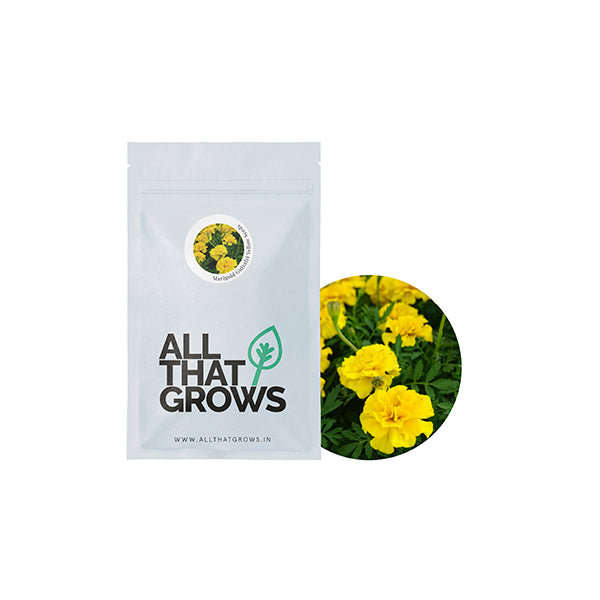



- SOWING
TIMEJan-Feb (Northern plains) March-April (Hills), March- May (South India)
- Sowing
Distance12 x 12 inches plant to plant
- Fruit
WeightN/A
- Fruit
ShapeN/A
- Days to
maturityAfter 45-50 days from transplanting.
- Details
- How to sow
- Reviews
Marigold flowers are made up of multiple layers of overlapping petals with the petals getting smaller and more condensed towards the centre of the flower, similar to that of a carnation. The blooms may be single or double coloured and can be varying hues of yellow, orange, red and maroon. Marigold is one of the most commonly grown flowers for garden decoration and extensively used as loose flowers for making garlands for religious and social functions. It has gained popularity amongst the gardeners on account of its easy culture and wide adaptability. Marigold requires mild climate for luxuriant growth and flowering. They can be planted in the beds for mass display or grown in pots. Marigold can be grown in a wide range of soils, as it is adapted in different soil types. The seedlings are easily transplanted and established in the field without much mortality. After transplanting, it takes 40-50 days to flower.
Planting instructions
Seeds should be sowed in pots, seed boxes or raised nursery beds.
They should be sown closely (6-8 cm row to row) and 2 cm deep, covered with thin layer of soil to allow germination.
After transplanting, a little water can be sprinkled over the soil.
The seeds germinate in 15-20 days.
Growing Requirements
pests
Marigolds are susceptible to damping off (Rhizoctonia solani) and pests like collar rat, Sclerotium rolfsii, Botrytis cinerea, Powdery mildew and cucumber mosaic. The major symptoms of these pests include light brown spots on the lower leaves or on early seedlings. To prevent these diseases, ensure proper drainage and ventilation and avoid over watering.
soil
Rich, well drained, and moist soils are best suited for marigolds.
spot
You can choose either a bright or partial sunny spot.
temperature
They grow best in a temperature range between 20-30°C
watering
Water the flowers regularly to keep them healthy. You can use either a water can or a spray.
how to harvest
For harvesting marigold, loose flowers are plucked when they attain full size depending upon the variety. Flowers should generally be harvested in the morning time. Irrigation of soil with water before plucking, gives better flower quality. Also, plucking of flowers regularly and removal of dried flowers enhances the yield.

The productiveness of any seed we sell is subject to your local climatic conditions*, the sowing method you adopt, and your commitment to the planting process. We give no warranty, expressed or implied, and are in no way responsible for the produce.
Please note that all our seasonal recommendations/ sowing information is as per the local climatic conditions. *For more information on the optimum conditions required for growing seeds in your region, please contact us at, hello@allthatgrows.in or Whatsapp us at, +91 8544865077
Questions & Answers
Have a Question?
Be the first to ask a question about this.




Marigold Gulzafri Yellow Seeds
Seed Type : Non-Hybrid, Open Pollinated and Non-GMO
Plant : Medium Tall , 2.0 to 3.0 feet high
Flower : Globe shaped flower with small coloured petals
Colour : Bright Yellow
Details : Long flowering period, Suitable for cut flowers.
Marigold flowers are made up of multiple layers of overlapping petals with the petals getting smaller and more condensed towards the centre of the flower, similar to that of a carnation. The blooms may be single or double coloured and can be varying hues of yellow, orange, red and maroon. Marigold is one of the most commonly grown flowers for garden decoration and extensively used as loose flowers for making garlands for religious and social functions. It has gained popularity amongst the gardeners on account of its easy culture and wide adaptability. Marigold requires mild climate for luxuriant growth and flowering. They can be planted in the beds for mass display or grown in pots. Marigold can be grown in a wide range of soils, as it is adapted in different soil types. The seedlings are easily transplanted and established in the field without much mortality. After transplanting, it takes 40-50 days to flower.
Seed Type : Non-Hybrid, Open Pollinated and Non-GMO
Plant : Medium Tall , 2.0 to 3.0 feet high
Flower : Globe shaped flower with small coloured petals
Colour : Bright Yellow
Details : Long flowering period, Suitable for cut flowers.
- SOWING
TIMEJan-Feb (Northern plains) March-April (Hills), March- May (South India)
- Sowing
Distance12 x 12 inches plant to plant
- Fruit
WeightN/A
- Fruit
ShapeN/A
- Days to
maturityAfter 45-50 days from transplanting.
Planting instructions
Seeds should be sowed in pots, seed boxes or raised nursery beds.
They should be sown closely (6-8 cm row to row) and 2 cm deep, covered with thin layer of soil to allow germination.
After transplanting, a little water can be sprinkled over the soil.
The seeds germinate in 15-20 days.
Growing Requirements
pests
Marigolds are susceptible to damping off (Rhizoctonia solani) and pests like collar rat, Sclerotium rolfsii, Botrytis cinerea, Powdery mildew and cucumber mosaic. The major symptoms of these pests include light brown spots on the lower leaves or on early seedlings. To prevent these diseases, ensure proper drainage and ventilation and avoid over watering.
soil
Rich, well drained, and moist soils are best suited for marigolds.
spot
You can choose either a bright or partial sunny spot.
temperature
They grow best in a temperature range between 20-30°C
watering
Water the flowers regularly to keep them healthy. You can use either a water can or a spray.
how to harvest
For harvesting marigold, loose flowers are plucked when they attain full size depending upon the variety. Flowers should generally be harvested in the morning time. Irrigation of soil with water before plucking, gives better flower quality. Also, plucking of flowers regularly and removal of dried flowers enhances the yield.



 Sign In
Sign In








